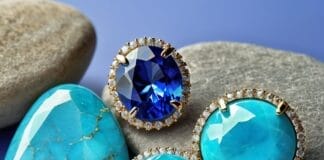Crystals are solid materials whose atoms, molecules, or ions are arranged in a highly ordered microscopic structure. This unique arrangement gives crystals their distinctive properties, including their hardness, also known as the hardness of a mineral.
The hardness of a crystal, or gemstone hardness, is a measure of its resistance to scratching or abrasion, and it plays a crucial role in identifying and classifying minerals.
The most widely used method for measuring the hardness of crystals, or the hardness value, is the Mohs Hardness Scale, also known as the scale of mineral hardness, developed by German mineralogist Friedrich Mohs in 1812.
The Mohs Scale Hardness
The Mohs Hardness Scale is a relative scale that ranks the hardness of minerals from 1 to 10, with 1 being the softest and 10 being the hardest. The scale is based on the principle that a harder mineral can scratch a softer mineral, but not vice versa. Each mineral on the scale can scratch the minerals below it and can be scratched by the minerals above it.

The minerals on the Mohs Hardness Scale are:
- Talc (Hardness: 1) – A soft, hydrous magnesium silicate mineral with a soapy feel and a pearly luster.
- Gypsum (Hardness: 2) – A soft sulfate mineral composed of calcium sulfate dihydrate, often used in the production of plaster.
- Calcite (Hardness: 3) – A carbonate mineral and the most stable polymorph of calcium carbonate.
- Fluorite (Hardness: 4) – A halide mineral composed of calcium fluoride, known for its vibrant colors.
- Apatite (Hardness: 5) – A group of phosphate minerals, usually referring to hydroxylapatite, fluorapatite, and chlorapatite.
- Orthoclase (Hardness: 6) – A feldspar mineral, a potassium aluminum silicate.
- Quartz (Hardness: 7) – A hard, crystalline mineral composed of silicon and oxygen atoms.
- Topaz (Hardness: 8) – An aluminum silicate mineral known for its hardness and variety of colors.
- Corundum (Hardness: 9) – A crystalline form of aluminum oxide, known for its hardness and abrasive properties. Sapphire and ruby are gem varieties of corundum.
- Diamond (Hardness: 10) – The hardest naturally occurring material, composed of carbon atoms arranged in a cubic crystal structure.
The Mohs Hardness Scale has several applications:
- Mineralogy: The scale is used to identify and classify minerals based on their hardness.
- Gemology: Gemologists use the scale to test the hardness of gemstones, which helps in their identification and in determining their suitability for various uses.
- Everyday use: The scale can be helpful in choosing the right tools and materials for a given task. For example, knowing the hardness of a material can help in selecting the appropriate abrasive for polishing or cutting.
Limitations of the Mohs Hardness Scale
While the Mohs Hardness Scale is widely used, it has some limitations:
- Relative nature: The scale is relative, meaning that the difference in hardness between the minerals is not evenly spaced. For example, the difference in hardness between diamond (10) and corundum (9) is much greater than the difference between talc (1) and gypsum (2).
- Materials not fitting neatly: Some materials, particularly gemstones, may not fit neatly into the scale due to variations in their composition and crystal structure.
Additional Considerations
- Crystallography: The hardness of a crystal is influenced by its crystal structure. The arrangement of atoms and the strength of the chemical bonds between them determine the crystal’s resistance to deformation.
- Mohs scale and gemstones: The Mohs scale is especially important in the world of gemstones, as hardness is a key factor in determining a gemstone’s durability and suitability for use in jewelry.
- Everyday materials and the Mohs scale: Many everyday materials can be roughly placed on the Mohs scale. For example, a fingernail has a hardness of around 2.5, a penny is about 3, and glass falls between 5 and 6.
Who was Friedrich Mohs?
German geologist and mineralogist Friedrich Mohs created the Mohs Hardness Scale in 1812, one of the most common scales used today. His scale, which ranges from 1 to 10, is a comparative tool used by the Gemological Institute of America and others to evaluate the hardness of minerals by observing which minerals can visibly scratch others.

Mohs selected ten minerals that were readily available for his scale, starting with talc, the softest mineral and assigned the number 1, and ending with diamond, the hardest, assigned the number 10. Mohs’ work was pioneering in the field of mineralogy, providing a practical method for identifying minerals in the field.
His scale remains in use today not only among geologists and gemologists but also in various industries related to materials science and engineering, including the manufacture of flat panel display components and touch screens in consumer electronics. Mohs’ contribution to mineralogy has been critical in advancing our understanding of material properties, which play a vital role in numerous applications, from manufacturing to jewelry design.
Mohs Hardness of Common Minerals
The Mohs scale of mineral hardness is remarkably effective due to its simplicity and practicality. By arranging 10 minerals from softest to hardest, it gives a clear and straightforward means to assess a mineral’s hardness through simple scratch tests. This method does not require specialized equipment, making it accessible for fieldwork and educational purposes, as endorsed by the National Park Service.
For example, quartz, which ranks 7 on the Mohs Scale, can scratch materials ranked lower, such as gypsum (ranked 2) or calcite (ranked 3), but cannot scratch diamond, the hardest mineral ranked at the top with a hardness of 10. This scale not only aids in identifying minerals but also helps in determining their applicability and wearability, particularly in jewelry, where a gemstone’s resistance to scratching is a critical attribute for its longevity and value.
Interestingly, no material is twice as hard as topaz (ranked 8), demonstrating the scale’s unique way of measuring hardness. Understanding the Mohs hardness of common minerals is fundamental for geologists, gemologists, and even enthusiasts engaged in rock collection or jewelry making, demonstrating the ongoing relevance of Mohs’ work in the modern world.
FAQ’s
What is the importance of the Mohs hardness scale in buying gemstones?
The Mohs hardness scale is crucial in the gemstone buying guide because it helps determine the durability and scratch resistance of the stone. Gemstones with a hardness of 7 or above, such as those as hard as corundum, are considered suitable for everyday wear.
Can I test the hardness of a mineral at home?
Yes, you can use the Mohs hardness method of comparing hardness by using another substance of known hardness. For example, if you have a quartz (hardness 7), it can scratch any mineral with a lower ranking on the scale and can be scratched by any higher, like corundum or diamond.
Why is toughness different from hardness?
Hardness measures the resistance of a mineral to being scratched, while toughness refers to how well a mineral can resist breaking or chipping upon impact. A gemstone as hard as corundum may have high hardness but varies in toughness due to the presence of inclusions or other structural weaknesses.
Are all gemstones with high Mohs hardness suitable for all types of jewelry?
While a high Mohs hardness indicates good resistance to scratching, one must also consider other factors like toughness and the presence of inclusions. These factors can affect a gemstone’s overall durability, making some stones better suited for certain types of jewelry over others.
How can I use the Mohs hardness scale for everyday purposes?
The Mohs hardness scale is useful for identifying minerals or verifying gemstones. For instance, with a guide like Theophrastus’s, you could use a steel file (hardness 6.5) to scratch test a quartz watch face to check its authenticity, showing a practical way to compare hardness in daily situations.
Conclusion
The Mohs Hardness Scale, also known as the Mohs Scale of Hardness, is a fundamental tool for understanding and classifying crystals based on their hardness. By grasping the principles of this scale, geology enthusiasts, crystal collectors, and science educators can better appreciate the properties and uses of various minerals. For example, an emerald falls between 7.5 and 8 on the Mohs scale, indicating a relatively high degree of hardness.
While the Mohs scale has some limitations, it remains the most widely used method for assessing mineral hardness. It provides a simple grading system ranging from 1 (talc) to 10 (diamond), allowing for a quick comparison of hardness between substances. Alternative hardness scales, such as the Vickers scale and the Brinell scale, offer more quantitative measurements but require specialized equipment and typically assess hardness at different scales, often used for materials with a hardness value greater than 5.5 to 6.5 on the Mohs scale.
We encourage readers to use the Mohs Hardness Scale to identify and explore the crystals they encounter, whether in nature, in the laboratory, or in their everyday lives. By doing so, they can deepen their understanding and appreciation of these fascinating materials.
























































